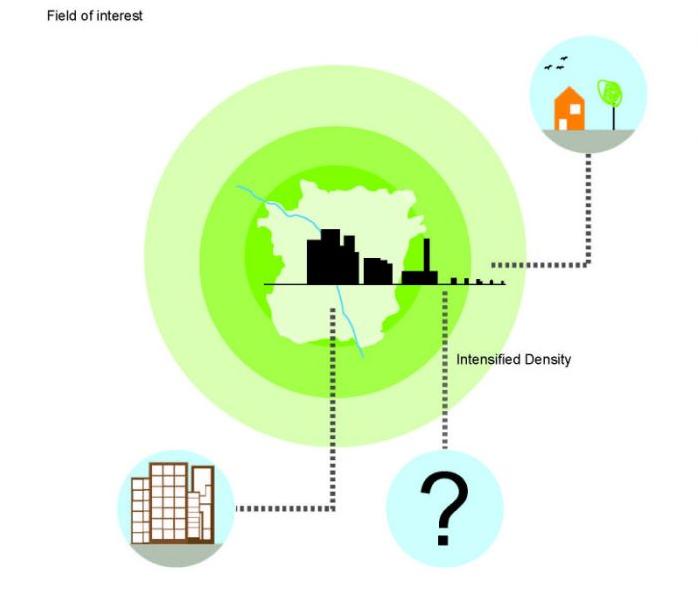Intensified Density - a small scale densification strategy for the suburbs by using modular construction
Short Description
Starting point/Motivation
The project Intensified Density, which is part of the research programme "Stadt der Zukunft" (City of the Future), investigates whether a small-scale densification strategy for the peri-urban zone, using modular construction, and existing infrastructure on empty plots of land, can offer a competing alternative to not only the sprawl of single family dwellings but also to large projects, which apply technology to achieve sustainable architecture and urban planning. Intensified Density is a response to the growing urban sprawl, which The Austrian Conference on Spatial Planning has recognised since the 1990s as needing to be restrained.
Contents and Objectives
In order to counteract this expansion of residential developments, within the framework of Intensified Density new developments in the building industry will be used, and modular building techniques will be investigated for densification strategies, which are able to demonstrate the necessary flexibility to respond to each respective context and offer cost-efficient alternatives. While prefabricated and standardized building techniques are usually planned independently from their future surroundings, Intensified Density intends to research how such structures can be connected to existing technical and social infrastructure and activate and develop their potential. This comprehensive approach is to be understood as part of a process of rethinking, where the usual roles of architects and urban planners are extended and become part of a shift that allows society's current problems to be identified, researched and changed, sustainably.
Methods
By means of the case study Graz varied methods were combined ranging from Mapping, Research through Design and conventional collection of data and analysis within the field of urban planning. Using modular construction, five scenarios on two plots, each exhibiting a different typology in order to make full use of the site's potentials were developed. A major factor lay in the interdisciplinary composition of the research team allowing for an inclusion of structural and structural-physical aspects right from the beginning of the design process.
Results
Intensified Density wants to shift the focus towards the peri-urban zone or so-called periphery that within city planning debates often remains neglected and generate a sustainable urban benefit by the employment of technological advanced and socially and culturally viable architectural means. The project aims at demonstrating possibilities of how to activate underused building land and be an inspiration for the development of contextually embedded, forward looking, denser small-scale dwelling types.
After conducting analyses of urban development of the portfolio and the socio-cultural environment, analyses of the existing design material, surveys and instruments in the city of Graz, as well as site inspections, approximately 120 plots of land were surveyed. The results of this survey provide a good overview of the existing land potential of the city. If and how these areas can actually be capitalized upon would have to be clarified in a separate step, enlisting the cooperation of local planners, neighbours and, above all, owners. Accordingly, the selection criteria used to choose and assess these properties must be evaluated and refined in a subsequent step. The selected properties serve as stimuli, increasing the visibility of forgotten potential of the areas.
The methodical approach of the "research-based design" taken in this project was to create a specific design at a real location in a way one would create a design in an architectural office. For example, an element or modular design method, the "One Room Planning System", was created and tested on the basis of five designs with different building and residential typologies, which ranged from high-rise buildings to townhouses and from the smallest apartment to maisonettes, as well as potential commercial uses on all floors.
Prospects / Suggestions for future research
A long-term goal is the implementation in the form of a pilot project in cooperation with a local authority, housing association or developer, and companies within the construction industry. Apart from the development of modular, but demand-oriented building construction methods, also the formulation of a multi-criteria catalogue containing proposals and methods for re-densification responding to specific environments is targeted in a further step.
Project Partners
Project management
Univ. Prof. Architektin BDA Dip.Arch. Petra Petersson - Graz University of Technology, Institute of Construction and Design Principles
Project or cooperation partners
- Graz University of Technology - Institute of Structural Design
- University of Applied Sciences Potsdam - Special field Construction Engineering
Contact Address
Graz University of Technology - Institute of Construction and Design Principles
Kronesgasse 5
A-8010 Graz
Tel.: +43 (316) 873 1631
Fax: +43 (316) 873 1632
E-mail: koen@tugraz.at
Web: http://koen.tugraz.at/

